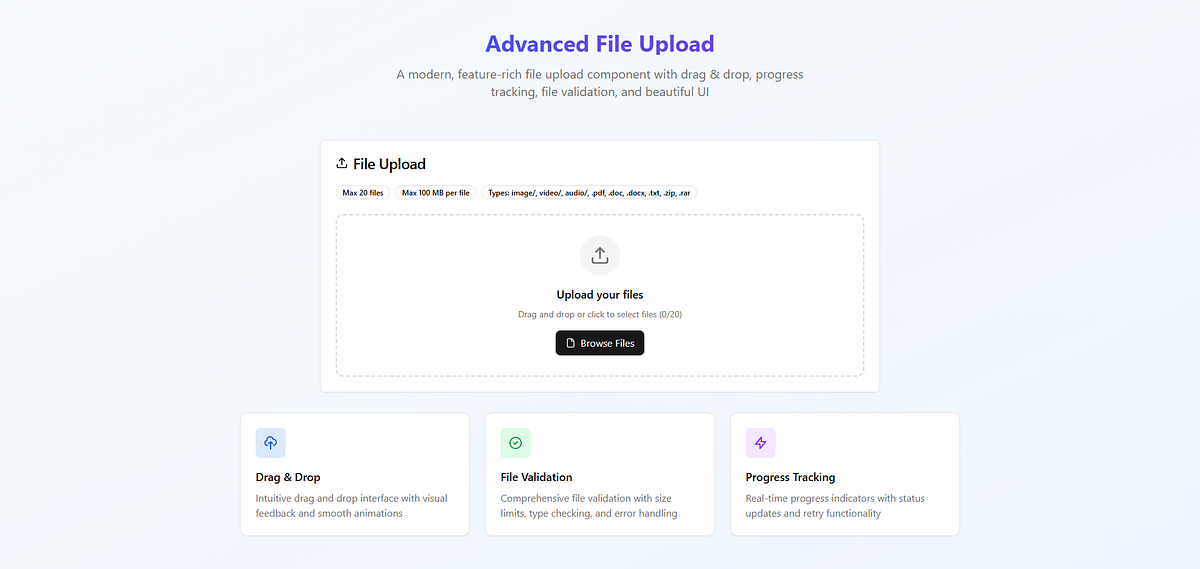🚀 Uploading 1GB Files in the Browser with Next.js,
🚀 Uploading 1GB Files in the Browser with Next.js, AWS S3 & Presigned URLs — My Journey, Learnings & Gotchas
“What if I told you that uploading a 1GB file directly from your frontend can be done securely, efficiently, and reliably without melting your server?”
🌟 The story begins…
Not long ago, I decided to build a Next.js file uploader for large files (think: PDFs, ZIPs, videos). My goal?
Let the browser upload files directly to S3 with no heavy server load — and track the progress beautifully, even if the file is 1GB or more!
At first, it sounded easy — “just use S3 and a few APIs.”
But oh boy… I was wrong 😅
That’s where Multipart Uploads with Presigned URLs came to the rescue. Here’s the full story of how I built it, what I learned, and how you can do it too — the right way. 💪
📦 What is Multipart Upload? Why should you care?
When you upload a large file to S3, doing it in one go is risky — what if the network drops? Or the browser crashes?
Multipart upload solves this by:
- Splitting the file into small parts (e.g., 5MB–25MB)
- Uploading each part independently (even in parallel!)
- Then telling S3 to assemble them back together 💡
🔐 And what about Presigned URLs?
Presigned URLs let your frontend upload directly to S3 without exposing your AWS credentials. Think of it like a “temporary signed permission slip” that lasts for a few minutes.
🧰 Tech Stack
Layer Tech Framework Next.js (API Routes) Cloud AWS S3 Auth method Presigned URLs SDK used @aws-sdk/client-s3 UI Features Drag & drop, chunk progress, error handling
🪄 Step-by-Step: How I Built the Multipart Upload System
Here’s the 30,000ft view of what happens when you upload a file 👇
1️⃣ Frontend sends file info
POST /api/create-multipart-upload
→ Returns { uploadId, key }2️⃣ File is split into 100 equal chunks
I used JavaScript’s file.slice(start, end) to split the file.
You can configure chunk size or chunk count (e.g., 5MB or 100 parts).
3️⃣ Request Presigned URLs
POST /api/get-upload-urls
→ Returns signed PUT URLs for each part4️⃣ Upload chunks using fetch(PUT) + AWS Presign URL
Each chunk uploads to its respective URL with Content-Type: application/octet-stream.
🧐 Tip: You can upload parts in parallel to save time!
5️⃣ Complete the Upload
POST /api/complete-upload
→ AWS assembles all parts into a final fileDone. 🎉 You’ve uploaded a 1GB file without stressing your server at all!
💥 Real Challenges I Faced (and Solved!)
🤩 1. CORS Issues
Problem: Browser blocked my S3 uploads 😠
Fix: I configured the S3 bucket’s CORS policy like this:
[
{
"AllowedHeaders": [
"*"
],
"AllowedMethods": [
"PUT"
],
"AllowedOrigins": [
"http://localhost:3000",
"https://next-js-s3-multipart-file-upload.vercel.app/"
],
"ExposeHeaders": [
"ETag"
],
"MaxAgeSeconds": 3000
}
]For production, restrict AllowedOrigin to your frontend domain.
🤩 2. 2-Minute Timeouts on Uploads
Some parts were failing when the upload took >2 minutes
Fix: I reduced my chunk size to 10–20MB and limited parallel uploads to 3–5 at a time. This ensured better stability in low-bandwidth cases.
🤩 3. Tracking Progress Per Chunk
How do I show upload progress?
Solution: Each chunk upload returns after fetch(PUT).
I calculated the percentage like this:
progress = ((completedChunks / totalChunks) * 100).toFixed(2);🤩 4. Re-uploading Failed Parts
What if one part fails?
I built logic to retry failed uploads using a simple retry loop. In future, I plan to add:
- Pause/resume
- Abort upload
- Upload history with DB
📋 AWS Docs That Helped Me (Big Time)
📂 My GitHub Repo
👉 Next.Js-S3-Multipart-File-Upload
Includes:
/apiroutes: create, presign, complete, abort/utils: upload logic- UI: file picker, progress bar, error status
💡 Final Tips — From Me to You
- 🔒 Never upload files directly to your backend — let S3 handle it.
- 🧱 Always split big files — even 1GB is manageable with smart chunks.
- 🚫 Watch out for CORS and expired presigned URLs.
- 🚀 Use
@aws-sdk/client-s3instead of olderaws-sdk.
🤝 Wrapping Up
Building this was like solving a Rubik’s cube — tricky at first, but fun once you understand the layers.
Now I can upload gigabyte-sized files with progress tracking, parallel uploads, and 100% security 🔐
I hope this blog helps you skip the guesswork and build your own version faster and better.
Happy uploading! 🚀
Feel free to reach out to me on GitHub or LinkedIn if you have questions or want to collaborate!


